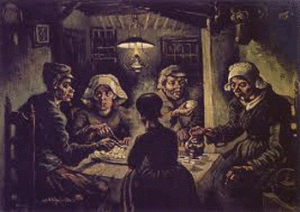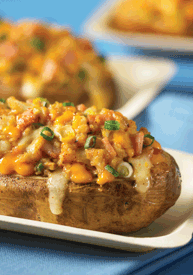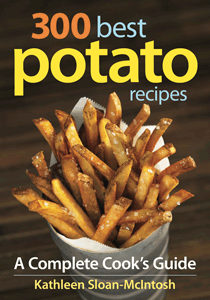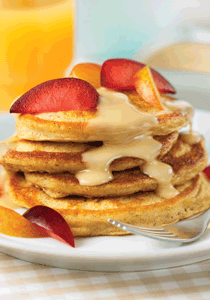©2012
This hand-clapping rhyme is recited by thousands of English-mother-tongue children to count and eliminate fists when it comes to choosing who will be “it” — the leader, the hunter, the counter at the start of an outdoor game. Instead the number 4,000 refers to the number of different edible varieties of potatoes known worldwide.
 |
|
The Potato Eaters, by Vincent Van Gogh, 1885
|
History
Today the potato is the world’s fourth largest food crop, following rice, wheat, and maize. This inexpensive tuber, often incorrectly maligned as fattening, originated between 10,000-7,000 years ago in the border area of modern-day southern Peru and extreme northwestern Bolivia, where it grew wild before being cultivated and preserved by freezing at high altitude by the Incas, who created a kind of freeze-dried potato preparation they called chuño. Today thousands of potato varieties still persist in the Andes.
Columbus brought back the sweet potato to Spain from Haiti in 1492, but how the non-sweet potato made its way to Europe is a matter of some dispute. The most likely theory is again thanks to the Spaniards and dates to the years immediately following the Spanish conquest of the Inca Empire. In fact, the first mention of the potato by a European dates to 1553, in the four-part book Crónicas del Perú, when its author, Spanish conquistador and chronicler of Peru, Pedro Cieza de León (c. 1520-1554) mentions that he had seen some in Quito, Popayán, and Pasto in 1538. This would make sense because, after several years of preliminary exploration and military skirmishes, 169 Spanish soldiers under General Francisco Pizarro and with their native allies ambushed the Sapa Inca Atahualpa (Emperor of the Inca Empire) and captured him in the November 16, 1532 Battle of Cajamarca. Thus the crews of Spanish ships returning home from Peru with their precious cargoes of silver and gold, presumably stocked up on potatoes, dubbed “edible stones,” for their food during their voyage. Historians speculate that leftover tubers would have been taken ashore and planted. This would confirm the fact that Basque fisherman from northern Spain used potatoes as ships’ stores for their voyages across the Atlantic in the late 16th century, and introduced the tuber to western Ireland, where they landed to dry their cod. Moreover, the first written mention of the potato’s arrival in Europe is a receipt for delivery dated November 28, 1567 from Las Palmas in the Grand Canaries, a certain stopover by Spanish ships returning home from South America, to Antwerp.
 |
|
Twice Baked Jacket Potato photo © Colin Erricson
|
Spanish explorers and sailors also introduced the tuber’s name to Europe. For the English word potato comes from the Spanish patata (still its name in Spain and Italy). The Spanish Royal Academy says the Spanish name is a compound of the Taino (Pre-Columbian inhabitants of the Caribbean) batata (sweet potato) and the Quechua (language of the Incas) papa (potato). The name patata originally referred to the type of sweet potato, brought by Columbus to his patrons King Ferdinand and Queen Isabella in 1492, rather than the other way around, although there is actually not a close relationship between the two plants. It was the English who confused the two plants one for the other.
A second, but less likely, theory of the potato’s arrival in Europe gives the credit to two Englishmen: privateer Sir Francis Drake, returning from his circumnavigation of the globe (1577-80) or astronomer, mathematician, ethnographer and translator Thomas Harriot (c.1560-1621), an employee of Sir Walter Raleigh, who accompanied the 1585 expedition to Roanoke funded by Sir Walter Raleigh and led by Sir Ralph Lane.
No matter who introduced it, thirty years after its arrival in Europe, the potato could be found in eleven countries: Spain, Austria, Holland, Germany, Belgium, Switzerland, England, France, Italy, Portugal, and Ireland. Although at first it was popularly considered poisonous because it grew underground and belonged to the same family as deadly nightshade, the potato spread across the Old World thanks to the Spanish Empire covering most of Europe, whose soldiers survived on this tuber. Peasants along the army’s route also began to adopt this crop, which was less often pillaged by marauding armies than the aboveground stores of grain. Not to mention that famines in the early 1770s contributed to its acceptance, for at times when and where most other crops failed, potatoes could still typically be relied upon to contribute adequately to food supplies.
The first individual champion of the potato was French physician, pharmacist, and agriculturist Antoine-Augustin Parmentier (1737-1813) who studied the potato and wrote a thesis Examen chymique des pommes de terres (Paris, 1774) singing the praises and virtues of the potato especially as a food source for the poor. He knew them firsthand because, while serving as an army pharmacist for France during the Seven Years’ War, he was captured by the Prussians and had spent time in a Westphalian prisoner-of-war camp, where the he was given only potatoes to eat. Luckily for Parmentier, at that time the Germans also believed the kartoffel was only fit for pigs and prisoners. Still also known to the French only as hog feed and believed to cause leprosy, the vegetable had kept Parmentier alive!
After his return to Paris in 1763, Parmentier pursued his pioneering studies in nutritional chemistry. Because of his prison experience he proposed (in a contest sponsored by the Academy of Besançon) the use of the potato as a source of nourishment for dysenteric patients and won. Thus, thanks largely to Parmentier’s efforts, the Paris Faculty declared potatoes edible in 1773. After this Parmentier began a series of publicity stunts for which he remains famous today, hosting dinners at which potato dishes featured prominently and guests included luminaries like Benjamin Franklin. After a year of bad harvests in 1785, where the scorned potato staved off famine in northern France, Parmentier convinced King Louis XVI and his court of their enormous nutritional value and they eagerly promoted this new crop whose production soared from 21 million hectoliters in 1815 to 117 million in 1840.
In fact, throughout Europe, during the 19th century the most important new food was the potato. It had three major advantages over other consumer foods: its much lower rate of spoilage, its bulk (which easily satisfied hunger), and its cheapness. Potatoes comprised about 10% of the caloric intake of 19th-century Europeans. Nonetheless, in Ireland, where the rainy climate and damp soil were well-suited to the potato, heavy dependence on the potato as the food staple (Irish historian Austin Bourke estimated that 3,000,000 of his fellow-citizens, or 40% of the population then, were living solely on potatoes) led to disaster when between 1845-49 the potato blight, Phytophthora infestans, quickly turned newly harvested potatoes into putrid mush causing millions of deaths from starvation and massive emigration (over 1,000,000 peasants) to Britain, the USA, and Canada.
Role in Today’s Food Supply
The FAO, the Food and Agriculture Organization of the United Nations, reports that the world production of potatoes in 2009 was 330 million tons in over 100 countries. Just over two-thirds of the global production is eaten by human beings with the rest being fed to animals or used to produce starch. The annual diet of an average global citizen in the first decade of the 21st century included 73 pounds of potato, today the world’s favorite vegetable. In fact, it’s almost a perfect food. An average serving of a baked potato of about 150 grams provides zero fat, cholesterol or salt and is only around one hundred calories, that’s less than a small container of cottage cheese.
The local importance of the potato is extremely variable and rapidly changing. Until 1900 Europe and North America were the largest potato producers; two-thirds of U.S. potato production still come from Idaho Washington, Oregon, Colorado, and Maine. It remains an essential crop in Europe (especially eastern and central Europe), where per capita production is still the highest in the world, but the most rapid expansion over the past few decades has occurred in southern and eastern Asia. China is now the world’s largest potato-producing country, and nearly a third of the world’s potatoes are harvested in China and India. The geographic shift of potato production has been away from wealthier countries toward lower-income areas of the world, although the degree of this trend is ambiguous. Due to its minimal presence in world financial markets and thus its stable pricing, the United Nations declared 2008 “The International Year of the Potato.” For the potato, not only its consumers deserve the name Epicurean-traveler!

300 Best Potato Recipes
Besides Parmentier, another French champion of the potato was a Madame Méridiot, who in 1793, only a few years after the Revolution, decided to write a cookbook designed for the common folk. Entitled, La Cuisine républicaine, its contents are entirely devoted to the potato. Unable to get her hands on a copy of this book, Canadian author Kathleen Sloan-McIntosh thought it was about time that another woman wrote a cookbook “lauding the world’s favorite vegetable.” Her 300 best potato recipes: A Complete Cook’s Guide, published in November 2011 by Robert Rose in Canada (www.robertrose.ca), is the splendid result: $24.95 USA. In her introduction Ms. Sloan-McIntosh, who, with her husband Ted, since 2006 has “owned and operated the black Dog Village Pub & Bistro in the village of Bayfield, a unique community perched on the shores of magnificent Lake Huron,” explains that her on-going love affair with the potato is due to the Northern Irish origin of her father’s family and her English mother’s inspiring culinary talent.
Sloan-McIntosh’s introduction is followed by two splendid chapters: “The Spud from All Angles” and “A World of Potatoes.” The first begins with a history of the potato and continues with practical information on buying and cooking potatoes, choosing the appropriate type of potato for each dish, the how-to’s of baking, boiling, browning, mashing, deep-frying, shallow-frying, crushing, steaming, and roasting the potato. The how-to’s of cooking are followed by the how-to’s of growing your own and storing them. The chapter also includes boxes of mainly historical anecdotes. One of my favorites is “Better Drunk than Stoned?”: “Nineteenth-century philosopher Friedrich Nietzsche maintained ‘a diet that consists predominantly of rice leads to the use of opium, just as the diet that consists predominantly of potatoes leads to the use of liquor.’” Another is “Potato Rituals”: “Not surprisingly, the Irish have a number of rituals associated with potatoes. In Cork the first potatoes were always unearthed on June 29. In Galway it was forbidden to dig potatoes until the last Sunday in July. Residents of County Mayo celebrated the end of harvest with a feast, and in Tipperary the arrival of new potatoes on the table was met with ‘May we all be alive and happy this time 12 months.’”
 |
|
Sweet Potato Pancakes with Maple Butter photo © Colin Erricson |
The second chapter, “A World of Potatoes,” explains potato types: floury (best for baked and mashed): Idaho Russet Burbank, King Edward, Estima, Fabula, and British Queen; waxy (Sloan-McIntosh’s favorites): Jersey Royal, Kipfler, Maris Baird, Pink Firr Apple, and Belle de Fontenay; and all-purpose (best for mashed, gratins, crushed with butter, and frites and chips): Yukon Gold, Kennebec, Bintje, Kerr’s Pink, and Maris Piper. It goes on to give a glossary of many types of potatoes and where they are grown. She explains: “While the international Potato Center in Peru boasts a collection of 4,000 potato varieties, actually only about 400 to 500 varieties of potatoes are in active production around the world. Many factors must be considered before a potato variety gains real popularity: resistance to disease, storage capabilities and whether a specific variety has the cooking characteristics that may currently be in demand for that type of potato.
Sloan-McIntosh’s 300 recipes, many of which are photographed, are divided into the following chapters: Top Twenty Classics; A Bowl of Soup; Salads; Appetizers; Snacks, Small Plates & Light Meals; Sensational Spuds on the Side; Main Courses with Meat, Poultry, Fish & Seafood; Vegetarian Mains to Satisfy; Breads, Biscuits, Scones, Griddle Cakes and More; and Desserts & Confections. These include recipes from: Africa, Belgium, Brazil, Canada, Canary Islands, China, Denmark, England, France, Germany, Greece, India, Ireland, Italy, Mexico, Morocco, Peru, Poland, Russia and Eastern Europe, Scotland, Spain, Switzerland, Sweden, Thailand, The Netherlands, Ukraine, and United States. The recipes are followed by a comprehensive index.
In short: Fadda beo na prátai! Gaelic for Long live the potato!
For three recipes excerpted from 300 Best Potato Recipes, click here.
& & &
